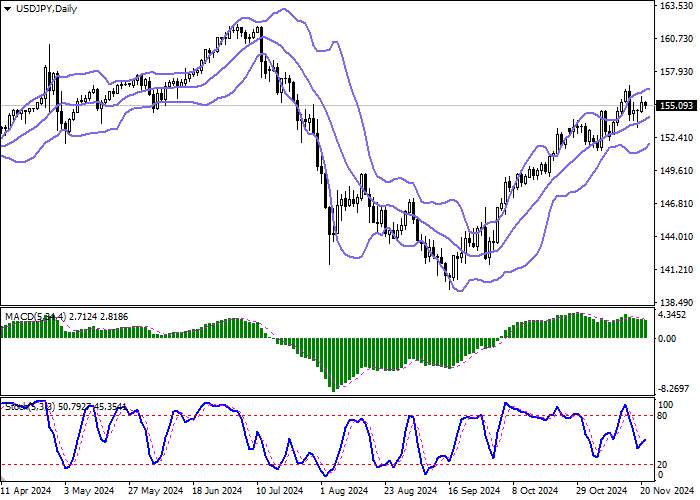
| situation | |
|---|---|
| Time frame | Intraday |
| Introduction | SELL STOP |
| Entry point | 154.50 |
| Make Profit | 152.50 |
| Stop Loss | 155.50 |
| Key Levels | 152.50, 153.18, 153.87, 154.50, 155.50, 156.50, 157.50, 159.00 |
| Alternative scenarios | |
|---|---|
| Introduction | BUY STOP |
| Entry point | 155.50 |
| Make Profit | 157.50 |
| Stop Loss | 154.50 |
| Key Levels | 152.50, 153.18, 153.87, 154.50, 155.50, 156.50, 157.50, 159.00 |
Current trends
During the Asian session, the USD/JPY pair is consolidating around 155.00 amid stronger technical factors. While the fundamental background has changed insignificantly, market participants are actively investing in the US currency after the victory of Republican Donald Trump in the presidential election. They associate his new term with a tightening of tax policies and, as a result, new inflation risks. The latter could lead to a more limited rate cut by the US Fed, as the prospect of accelerating consumer price growth is already emerging.
On the other hand, the market expects the Bank of Japan to gradually tighten monetary policy, but so far the monetary authority has not given a clear forecast on its long-term plan to adjust the parameters. Analysts are now pricing in a 25 basis point change in borrowing costs to just 40.0% , following a speech by BoJ Governor Kazuo Ueda , who stressed that raising interest rates would be key to preventing a rapid acceleration in inflation and ensuring long-term economic growth, confirming his readiness to continue his " hawkish " stance at the December meeting. Meanwhile, officials indicated that the US economy is likely to achieve a soft landing due to positive statistics, while the market is confident that foreign trade will soon come under pressure due to the Trump administration's tax changes. This would create additional difficulties for manufacturers and could lead to a recession, meaning the BOJ is unlikely to raise interest rates again before early next year. According to Ueda, core inflation, which excludes short-term changes such as higher import prices, remains below the 2.0% target, but the agency forecasts it will continue to recover, facilitated by the wage index. Meanwhile, Japan's macroeconomic statistics released yesterday failed to support the national currency's position : Exports were revised up by 3.1% year-on-year after falling 1.7% last month, with a preliminary estimate of 2.2% , while imports, on the other hand, slowed from 1.8% to 0.4%, although the forward estimate was for a -0.3% revision. However, the overall trade deficit in October remained flat, widening from the previous -294.1 billion yen to -461.2 billion yen. Investors will be focused tomorrow on October inflation figures, with the national consumer price index excluding food prices likely to slow to 2.2 % year-on-year from 2.4% , while the business activity index in the manufacturing and services sectors in November is likely to be revised from 49.2 points to 49.5 points and from 49.7 points to 49.3 points, respectively.
Support and resistance
On the daily chart, Bollinger Bands are showing a confident rise : the price range is narrowing, reflecting the emergence of ambiguous dynamics in the very short-term perspective. MACD is maintaining a bearish sell signal, staying below the signal line, and Stochastic is showing a sharp bounce back upwards at the beginning of the week.
Resistance levels : 155.50, 156.50, 157.50, 159.00
Support levels : 154.50, 153.87, 153.18, 152.50


Trading Tips
Short position may be opened after break at 154.50 with target at 152.50 stop loss – 155.50. Execution period : 2-3 days.
Long position may be opened after rebound from 154.50 and break at 155.50 with target at 157.50 stop loss – 154.50.
风险提示:以上内容仅代表作者或嘉宾的观点,不代表 FOLLOWME 的任何观点及立场,且不代表 FOLLOWME 同意其说法或描述,也不构成任何投资建议。对于访问者根据 FOLLOWME 社区提供的信息所做出的一切行为,除非另有明确的书面承诺文件,否则本社区不承担任何形式的责任。
FOLLOWME 交易社区网址: www.followme.com


加载失败()